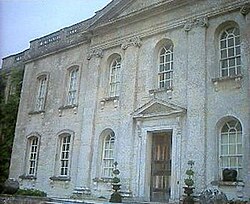Kingston Russell House
| Kingston Russell House | |
| Dorset | |
|---|---|
 Kingston Russell House | |
| Location | |
| Grid reference: | SY57208956 |
| Location: | 50°42’15"N, 2°36’27"W |
| Village: | Kingston Russell |
| History | |
| Built 1730 | |
| Country house | |
| Georgian | |
| Information | |
Kingston Russell House is a large mansion house and manor at Kingston Russell near Long Bredy in Dorset, to the west of Dorchester. The present house dates from the late 17th century but in 1730 was clad in a white Georgian stone facade. The house was restored in 1913, and at the same time the gardens were laid out.
=History
Middle Ages
The house is on land which was granted to the local Russell family, probably by King John, or by his son King Henry III. Kingston Russell manor is now part of Long Bredy parish, but earlier appears to have had its own church.
The is recorded that the family had held the estate since the time of William the Conqueror by 'grand serjeanty', which is to say in return for continued service to the King; in this case of being marshal of the king's buttery at Christmas and at Pentecost. The serjeanty changed during the minority of King Henry III to the counting of the King's chessman and storing them away after a game. In 1284, King Edward I granted to William Russell a market and free warren, as recorded in the Charter Rolls records:[1]
Grant to William son of Ralph Russel, and his heirs, of a weekly market on Thursday at his manor of Kyngeston Russel, co. Dorset, and of a yearly fair there on the vigil, the feast and the morrow of St Matthew (i.e. 21st. September) ; grant also of free warren in the demesne lands of the said manor.
Modern period
At some point possibly around the 1640s, part of the manor, including the house, came into the possession of the Michel family, who partly rebuilt the seventeenth century Kingston Russell House as it still stands today at the end of a long driveway. The Michel family also owned Dewlish House in Dewlish, Dorset and removed there sometime during the 1760s when the house was then let. Admiral Sir Thomas Hardy, 1st Baronet, Nelson's flag captain, was born at Kingston Russell on 5 April 1769, his mother being the daughter of Thomas Masterman of this place.
At some time before 1861, the Dukes of Bedford bought Kingston Russell, and when the Duke's 3rd son, Lord John Russell (1792–1878), the prominent Liberal statesman, was raised to the peerage as an earl on 30 July 1861, he chose the title Earl Russell of Kingston Russell. In 1877, the accomplished American historian, John Lothrop Motley, author of 'The Rise of the Dutch Republic', died at Kingston Russell.
By the turn of the twentieth century however, the house was in a dilapidated condition and the estate was sold in 1913 to George Gribble. He and his wife Norah Royds had previously renovated Henlow Grange. The new owners - with architect Philip Tilden, who later worked for Winston Churchill - demolished a stub wing from the older Tudor building, extended the Carolean/Georgian wing by the addition of two small three-storey wings at either end of the original two-storey structure, and laid out the gardens. The village hall was constructed as a gift to the village, in memory of their son who died in the Great War. The Gribble family moved away in the 1920s.
Present day
Since then, the house has had a number of different owners. Since 1984 it has been owned by Dr H. H. J. Carter & Miss T. Silkstone, who are the longest continuous owner-occupiers of the house since the 1760s. The house is not open to the public, though it has welcomed visitors from bodies such as the Georgian Group.
Chapel of St James
A small chapel dedicated to St James once stood nearby. It is reputed to have been built by the Russells and was financed by them through tithes and the glebe in Pitcombe. The last rector of the chapel was Roger Bond who was appointed to it, along with Little Bredy in 1531. The inhabitants then used the church at Long Bredy for burials. After its closure it was leased variously. In 1565 it was granted to Edith Cole, widow and John and Joan Martin, her children for their lives. It was then granted to John, Henry and William Mintern for their lives from 1585, then in 1605 to Fenton, esq. captain of the guard, and 1607 to George Ward. The chapel of St James then came to the Mellers of Little Bredy who sold the tithes and part of the glebe to the Michels. By this time the chapel was in ruins and in John Hutchins's time only the walls remained. During the time of the Michels residence of the manor, according to Hutchins, it was inhabited by poor people.
Outside links
| ("Wikimedia Commons" has material about Kingston Russell House) |
- b&w copyrighted photo of Kingston Russell c. 1955
- Local History Website
- Earthwork and geophysical survey of long barrows on South Dorset Ridgeway
References
- Scott-Thomson, Gladys,F.R.H.S. Two Centuries of Family History, London, 1930. A study of the Bed, Historical Memoirs of the House of Russell from the Time of the Norman Conq
- Gorges, Raymond. History of the Family of Gorges ("The Story of a Family through Eleven Centuries Illustrated by Portraits and Pedigrees Being a History of the Family of Gorges"), Boston USA, 1944. Extensive research on the Russell family.
- Church, S.D. The Household Knights of King John, Cambridge, 1999
- Pitt-Rivers, Michael, 1968. Dorset. London: Faber & Faber.
- "Kingston Russell & the Russell Family". http://www.weymouth-dorset.co.uk/kingston-russell.html.
